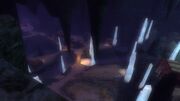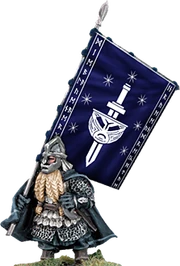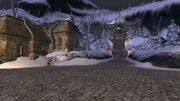The Blue Mountains or 'Ered Luin', also known as Ered Lindon, was a mountain range situated in the far west of Eriador.
History
Early Arda
The Blue Mountains arose sometime after the tumultuous chaos caused by Melkor's destruction of the Two Lamps that destroyed the perfect symmetry of Arda. In these early days, the Blue Mountains were located between the newly formed great sea of Belegaer and the newly formed Sea of Helcar. The Blue Mountains were connected to the Iron Mountains to the north and the Red Mountains in the east which formed one great mountain range chain known by different names. The Ancient Grey Mountains were to its south separated by a great gap.[1]
Eldar Days
During the Years of the Trees and the Sleep of Yavanna, the Blue Mountains was an unbroken line separating Eriador from Beleriand. Seven rivers arose in it on the western side, and the land these rivers flowed through was known as Ossiriand, which was later also known as Lindon, therefore the mountains were sometimes referred to as the Ered Lindon. Dwarven kinfolk either awoke here or migrated here from other awakening points and delved the cities of Belegost and Nogrod and made contact and alliance with the Sindar of Thingol.[2]
Second Age
The mountain range was broken during the war of the Valar against Morgoth, and at the middle of the range the sea broke through, creating a great gap where was set the Gulf of Lune a new terminus for the river Lune. In the middle of the gap, where the Lune met the sea, the Grey Havens of Mithlond of the Elven Kingdom of Lindon were built. When seen as the border of Lindon the Ered Luin were called Ered Lindon.

Location of the Blue Mountains in Middle-earth.
Third Age and beyond
During the Third Age, its forests, besides that of Mirkwood, were the largest in Middle-earth. In the latter part of the Third Age, the Dwarves settled the Blue Mountains again when Thráin II and his son Thorin and the Dwarven survivors of the Sack of Erebor moved from Dunland and delved a prosperous settlement there.[3] After the War of the Ring and the defeat of Sauron, Elves continued to travel west to Lindon through the gap in the mountains by way of the Gulf of Lune, where they eventually intended to set sail on the Straight Road to the Undying Lands of Aman.[4]
Inhabitants
Dwarves
While Morgoth was imprisoned in Mandos, and Middle-earth still lay under starlight, the first Dwarves came west over the Blue Mountains that bordered Beleriand. The origins of these Dwarves are unclear, but they seem to have arisen from two of the Fathers of their race, placed beneath the Mountains by their maker Aulë. These two Fathers gave rise to two clans, each of which had made a great city in the eastern side of the Blue Mountains. In the Dwarf-tongue these cities were known as Gabilgathol and Tumunzahar, but history remembers them by their Elvish names: Belegost and Nogrod.

Underground Dwarf homes in the Blue Mountains, as seen in The Lord of the Rings Online.
From their mountain-cities, the Dwarves of the Blue Mountains came down into Beleriand to trade with the Elves. They played a great part in the making of Thingol's halls at Menegroth, and later aided in the delving of Nargothrond beside Narog. In Nogrod during this period, the master craftsman Telchar forged weapons and armour that would be famed through Middle-earth's history, including Narsil, the sword that would be broken and reforged for Aragorn far in the future.
After Morgoth's return to Middle-earth, the Dwarves were loosely allied with the Elves in the Wars of Beleriand that followed. They fought in the Nirnaeth Arnoediad, where Azaghâl of Belegost drove Glaurung from the field, but was himself slain. After the Nirnaeth, relations between the Elves and Dwarves cooled: Dwarves of Nogrod slew Thingol and stole the Nauglamír, and after this time enmity and mistrust grew between the two peoples.
At the end of the First Age, the War of Wrath caused the destruction of much of Beleriand and its neighbouring lands. The Dwarves of the Blue Mountains did not escape: Nogrod and Belegost were destroyed by the inrushing Sea, and their people fled eastwards. Many came to Khazad-dûm and joined with the Longbeards there, but the time of the first Dwarves of the Blue Mountains had come to the end.

Dwarf warrior of Blue Mountains.
As the millennia passed, the Dwarves of Khazad-dûm that had welcomed the refugees from Nogrod and Belegost were themselves driven from their home, and wandered widely in Middle-earth. More than six thousand years after the old citadels of the Dwarves had been lost, these wandering Dwarves of Durins' Folk, under King Thráin II, returned to the Ered Luin. The seat of their Kings only remained there for a generation - Thráin's son Thorin set out to recover the Lonely Mountain in the distant east - but for a time the hammers of the Dwarves rang again among the Blue Mountains, as they had in ancient days. So a much smaller group of Durin's folk lived in the Ered Luin, if any. However the Firebeards and Broadbeams continued to live there through the Fourth Age, and probably till the diminishing of the race of Dwarves (There were and always will be Dwarves on the eastern side of the Blue Mountains).
Elves
It is shown in several maps made of Middle-earth that vast ancient forests flanked both sides of the Blue Mountains, even after the gargantuan slaughter of Eriador's great forests by the men of Númenor and their incessant appetite for lumber. These forests, alongside the fertile coastal plain, would prove to be hotspots for Elven migration and inhabitation.
It is stated at the very beginning of The Hobbit that the High Elves lived within the vales and forests of the Blue Mountains, presumably sharing the land with the Dwarves. To this number would be added Sindar, Wood-elves, and maybe even a few Avari.
The influx of new Elven settlers soared after the end of the First Age who lived under the Ñoldor High King Gil-galad in the Second Age.[5][6] After the fall of Gil-galad in the Third Age, the foot of the Blue Mountains became part of Lindon where Elves lived temporarily until they left for the Undying Lands, due to the Elves desiring to escape the woes and predicaments of Middle-earth.[7][8]
Geology
Although the Blue Mountains were little described (owing to their location on the fringes of all of Tolkien's tales), we can assume a bit of their geology. The outer layers of the mountains seem to have been underlaid by metamorphic rocks formed in contact with numerous igneous intrusions. This environment is often necessary to produce veins of ore such as those mined by the Dwarves from the beginning of time. This environment produced the trove of Gold, Silver, Iron, Gems, and other materials that made the Dwarf kingdoms incredibly wealthy.
The Blue mountains were shorter than the Misty Mountains, and not as high; their altitude was probably around 3000-4000 meters, on average.
Etymology
The Sindarin name for the mountains, Ered Luin is translated as the words ered ('Mountains') and luin ('Blue'). [9]
Portrayal in Adaptations
Video Game

A Dwarven settlement in Blue Mountains, as seen in The Lord of the Rings Online.
Central Ered Luin is amongst the regions fleshed out in The Lord of the Rings Online. Significant areas surrounding Dwarven and Elven settlements are available for exploration and adventuring. The Blue Mountains are only in the campaign in The Lord of the Rings: The Battle for Middle-earth II but may not in a skirmish.
Translations around the world
| Foreign Language | Translated name |
|---|---|
| Afrikaans | Blou Berge |
| Amharic | ሰማያዊ ተራሮች |
| Albanian | Blu Malet |
| Arabic | الجبال الزرقاء |
| Armenian | Կապույտ լեռներ |
| Azerbaijani | Mavi Dağlar |
| Basque | Mendi Urdinak |
| Belarusian Cyrillic | Блакітныя горы |
| Bengali | ব্লু পর্বতমালা |
| Breton | Glas Menezioù |
| Bosnian | Plava Planine |
| Bulgarian Cyrillic | Сините планини |
| Cambodian | ភ្នំខៀវ |
| Catalan | Muntanyes Blau |
| Cebuano | Asul nga mga Bukid |
| Chinese (Hong Kong) | 藍色山脈 |
| Cornish | Blou Menydhyow |
| Croatian | Modre Planine |
| Czech | Modré hory |
| Danish | Blå Bjerge |
| Dutch | Blauwe Bergen |
| Esperanto | Bluaj Montoj |
| Estonian | Sinimäed |
| Faroese | Bláurfjøll |
| Filipino | Asul na bundok |
| Finnish | Sinivuoret |
| French | Montagnes Bleues |
| Galician | Montañas Azul |
| Georgian | ცისფერი მთები |
| German | Blaue Berge |
| Greek | Μπλε Βουνά |
| Gujarati | બ્લુ પર્વતો |
| Haitian Creole | Mòn Ble |
| Hebrew | ההרים הכחולים |
| Hindi | ब्लू पर्वत |
| Hmong | Xiav Toj siab |
| Hungarian | Kék-hegység |
| Icelandic | Bláfjöll |
| Indonesian | Pegunungan Biru |
| Irish Gaelic | Gorm Sléibhte |
| Italian | Monti Azzurri |
| Japanese | ブルー・マウンテンズ |
| Javanese | Biru Gunung |
| Kannada | ನೀಲಿ ಪರ್ವತಗಳು |
| Kazakh | Көгілдір таулар (Cyrillic) Kögildir tawlar (Latin) |
| Korean | 청색산맥 |
| Kurdish | Çiyayên Şîn (Kurmanji Kurdish) |
| Kyrgyz Cyrillic | Көк тоолор |
| Laotian | ພູເຂົາສີຟ້າ |
| Latin | Caeruleus Montes |
| Latvian | Zilie Kalni |
| Lithuanian | Mėlynieji Kalnai |
| Luxembourgish | Blo Bierger |
| Macedonian Cyrillic | Сината Планина |
| Malagasy | Manga Tendrombohitra |
| Malay | Gunung Biru |
| Maltese | Muntanji Blu |
| Marathi | निळा पर्वत |
| Mongolian Cyrillic | хөх уулсын |
| Nāhuatl | Texohtic Tepetl |
| Navajo | Dootłʼizh Dził |
| Norwegian | Blåfjellene |
| Old English | Bleoh Beorgas |
| Pashto | زنگالي غرونو |
| Persian | کوه های آبی |
| Polish | Góry Błękitne |
| Portuguese (Brazil and Portugal) | Montanhas Azuis |
| Punjabi | ਬਲੂ ਪਹਾੜ |
| Romanian | Munții Albaștri |
| Romansh | Muntognas Blau |
| Russian | Синие горы |
| Samoan | Mauga lanu moana |
| Scottish Gaelic | Gorm Beanntan |
| Serbian | Блу Маунтинс (Cyrillic) Modre Planine (Latin) |
| Sindhi | نيرو جبلن |
| Sinhalese | නිල් කඳු |
| Slovak | Modré Vrchy |
| Slovenian | Modra Gore |
| Somalian | Baluug Buuraha |
| Spanish (Spain and Latin America) | Montañas Azules |
| Sudanese | Paul Pagunungan |
| Swahili | Buluu Milima |
| Swedish | Blå Bergen |
| Tajik Cyrillic | Кабуд кӯҳҳои |
| Tamil | நீல மலைகள் |
| Telugu | బ్లూ మౌంటైన్స్ |
| Thai | เทือกเขาบลู |
| Tongan | Ngaahi mo'unga lanu pulu |
| Turkish | Mavi Dağlar |
| Ukrainian Cyrillic | Блу Маунтінс |
| Urdu | دی بلیو ماؤنٹینز |
| Uzbek | Кўк Тоғлар (Cyrillic) Ko'k Tog'lar (Latin) |
| Vietnamese | Dãy núi Blue |
| Welsh | Mynyddoedd Glas |
| Yiddish | בלו בערג |
| Yoruba | Bulu Òkè |
| Yucatec Maya | Witso'obo' azules |
| Mountain Ranges of Arda |
|---|
|
Ash Mountains | Blue Mountains | Echoriad | Ephel Dúath | Ered Gorgoroth | Ered Lómin | Ered Wethrin | Grey Mountains (north) | Grey Mountains (south) | Iron Hills | Iron Mountains | Misty Mountains | Mountains of Angmar | Mountains of Mirkwood | Mountains of Mithrim | Mountains of the Wind | Orocarni | Pelóri | Walls of the Sun | White Mountains | Yellow Mountains |
| Dwarven realms of Middle-earth throughout the Ages | |
|---|---|
| Years of the Trees and First Age: | Amon Rûdh | Belegost | Khazad-dûm | Mount Gundabad | Nogrod | Narukuthûn | Blue Mountains |
| Second Age: | Khazad-dûm | Belegost | Nogrod | Mount Gundabad | Blue Mountains | Iron Hills |
| Third Age: | Grey Mountains | Iron Hills | Khazad-dûm | Lonely Mountain | Blue Mountains | Dunland |
| Fourth Age: | Glittering Caves | Khazad-dûm | Lonely Mountain | Blue Mountains | Iron Hills |
References
- ↑ The Atlas of Middle-earth, The First Age, The Elder Days, "Introduction"
- ↑ The Silmarillion, Quenta Silmarillion, Chapter X: "Of the Sindar"
- ↑ Unfinished Tales, Part Three: The Third Age, III: "The Quest of Erebor"
- ↑ The Atlas of Middle-earth, The Lord of the Rings, "The Road Home"
- ↑ The Atlas of Middle-earth, Thematic Maps, "Population"
- ↑ The Atlas of Middle-earth, The Second Age, "Refugee Relocation"
- ↑ The Lord of the Rings, The Fellowship of the Ring, Book One, Chapter III: "Three is Company"
- ↑ The Lord of the Rings, The Return of the King, Book Six, Chapter IX: "The Grey Havens"
- ↑ The Complete Guide to Middle-earth
